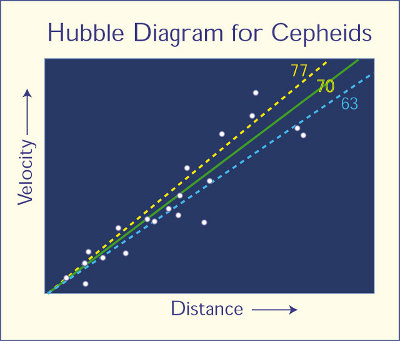I would then begin classifying all of the nebulae and measuring their distances and even their velocities. What I would discover would shock even me! I discovered that, similar to the relationship between luminosity (or magnitude) and distance, there is a quantifiable relationship between distance and velocity. The greater the distance between us and an object in space, the faster its velocity. In other words, the objects that are further away from the Earth are moving away from the Earth faster than the objects that are closer to us.
The relationship between distance and velocity was named after me: Hubble’s Law.
Hubble Diagram for Cepheids: This is a plot of galaxy distance versus the velocity that the galaxy appears to be receding from Earth. It is based on data collected by the Hubble Space Telescope Key Project team. The distances have been measured using Cepheid variables. The slope in the plot measures the expansion rate of the Universe, a quantity called the Hubble constant. The best fit to the data yields a Hubble constant of 70 kilometers/second/megaparsec. The dashed lines indicate Hubble constant values of 77 and 63 and do not fit the data as well. This plot is analogous to that obtained by Carnegie astronomer Edwin Hubble that led to his discovery of the expansion of the Universe. With the Hubble Space Telescope, it is now possible to measure Cepheid distances over 30 times farther away than Hubble was able to do.
Credit: NASA & ESA
The next time you look at the night sky and take in all of the light coming from stars and galaxies, remember how much we have learned by looking at the light from these far away places. And imagine how much we will learn in the future!


